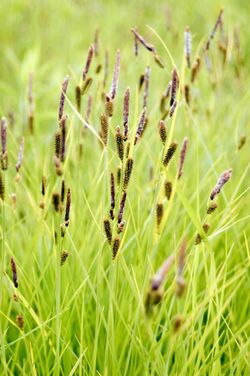Biology:Carex stricta
| Carex stricta | |
|---|---|

| |
| Scientific classification | |
| Kingdom: | Plantae |
| Clade: | Tracheophytes |
| Clade: | Angiosperms |
| Clade: | Monocots |
| Clade: | Commelinids |
| Order: | Poales |
| Family: | Cyperaceae |
| Genus: | Carex |
| Subgenus: | Carex subg. Carex |
| Section: | Carex sect. Phacocystis |
| Species: | C. stricta
|
| Binomial name | |
| Carex stricta Lam.
| |
| Synonyms | |
| |
Carex stricta is a species of sedge known by the common names upright sedge[1] and tussock sedge.[2] The plant grows in moist marshes, forests and alongside bodies of water.[3] It grows up to 2 feet (0.61 m) tall and 2 feet (0.61 m) wide. When the leaves die, they build on top of or around the living plant, making a "tussock".[3] Widely distributed in and east of the Great Plains,[4] it is one of the most common wetland sedges in eastern North America.[5]
Their seeds are carried by the wind.[citation needed] When seeds land, they are eaten by birds such as dark-eyed junco, northern cardinal, wild turkey, and ducks such as mallard and wood duck. The seeds are also eaten by squirrels and other mammals.[3] The plant can also reproduce vegetatively via rhizomes, and often form colonies.[3]
It is a larval host to the black dash, the dun skipper, and the eyed brown.[6]
References
- ↑ "Carex stricta Lam., upright sedge". PLANTS Profile. United States Department of Agriculture. http://plants.usda.gov/java/profile?symbol=CAST8. Retrieved May 22, 2013.
- ↑ Coladonato, M. 1994. Carex stricta. In: Fire Effects Information System, USDA Forest Service Rocky Mountain Research Station, Fire Sciences Laboratory.
- ↑ 3.0 3.1 3.2 3.3 Carex stricta. Study of Northern Virginia Ecology. Fairfax County Public Schools.
- ↑ "Carex stricta", County-level distribution map from the North American Plant Atlas (NAPA) (Biota of North America Program (BONAP)), 2014, http://bonap.net/MapGallery/County/Carex%20stricta.png, retrieved 15 April 2019
- ↑ Carex stricta. Flora of North America.
- ↑ The Xerces Society (2016), Gardening for Butterflies: How You Can Attract and Protect Beautiful, Beneficial Insects, Timber Press.
Wikidata ☰ Q15615554 entry
 |


